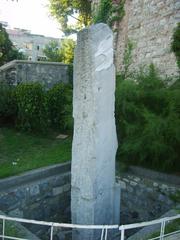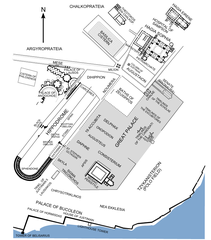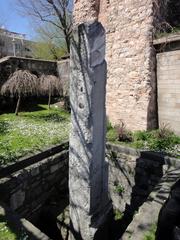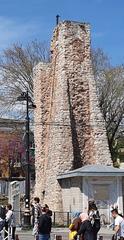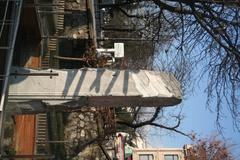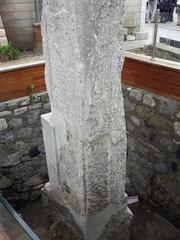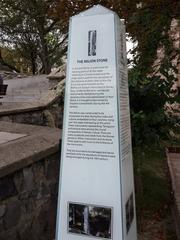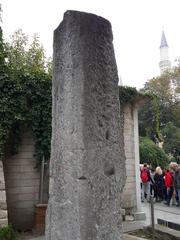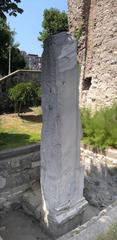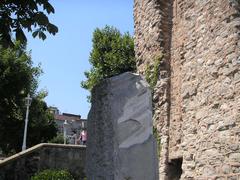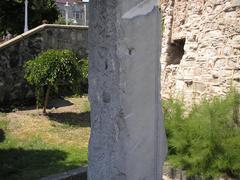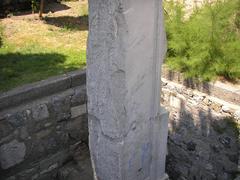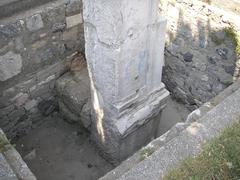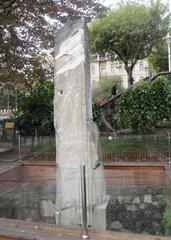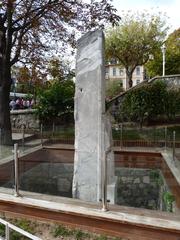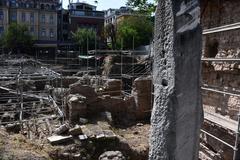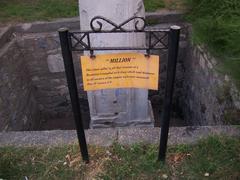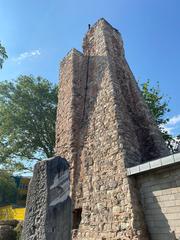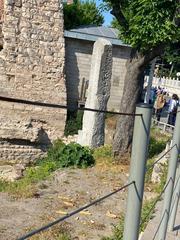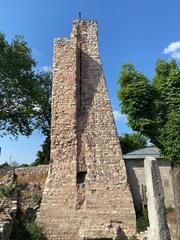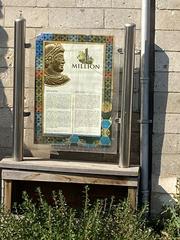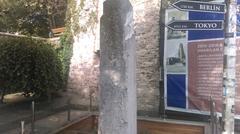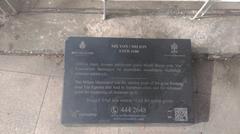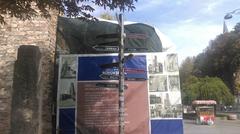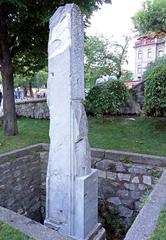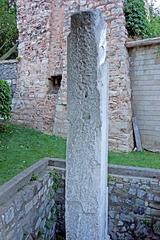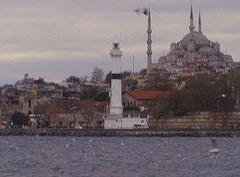
Visiting The Stone of Million: Hours, Tickets, History, and Tips
Date: 25/07/2024
Introduction
Discover the rich history and enduring allure of the Stone of Million, a significant landmark in Istanbul that has stood as a silent witness to the city’s storied past. Erected in the early 4th century AD during the reign of Emperor Constantine the Great, the Stone of Million, also known as the Milion, served as the zero-mile marker from which all distances in the Byzantine Empire were measured. This ancient milestone was not just a functional marker but a grand architectural marvel, symbolizing the centrality and importance of Constantinople in the ancient world (source). Today, the remnants of this historical monument continue to captivate visitors, offering a tangible link to the past and a profound understanding of Istanbul’s layered history. Whether you are a history enthusiast, a curious traveler, or someone seeking to connect with the past, the Stone of Million provides a unique and enriching experience in the heart of Istanbul.
Table of Contents
- Introduction
- History of The Stone of Million
- Visitor Information
- Educational Value and Modern-Day Relevance
- FAQ
- Conclusion
History of The Stone of Million
Origins and Historical Context
The Stone of Million, also known as the Milion, is a significant historical monument located in Istanbul, Türkiye. This ancient milestone was erected in the early 4th century AD during the reign of Emperor Constantine the Great, who founded Constantinople (modern-day Istanbul) as the new capital of the Roman Empire. The Milion served as the zero-mile marker from which all distances in the Byzantine Empire were measured, akin to the Milliarium Aureum in Rome (source).
Architectural Significance
The Milion was not merely a stone marker but a grand structure that included a domed building supported by four arches. It was adorned with statues and inscriptions, making it a prominent feature in the cityscape of Constantinople. The structure symbolized the centrality of Constantinople in the Byzantine Empire and its importance as a hub of commerce, culture, and governance (source).
Role in Byzantine Empire
The Milion played a crucial role in the administrative and logistical framework of the Byzantine Empire. It was the reference point for the empire’s extensive road network, which facilitated trade, military movements, and communication across vast distances. The distances to various cities and provinces were inscribed on the Milion, making it an essential tool for travelers and officials alike (source).
Decline and Rediscovery
With the fall of Constantinople to the Ottoman Turks in 1453, the significance of the Milion diminished. Over the centuries, the structure fell into disrepair and was eventually buried under layers of urban development. It wasn’t until the 1960s that the remnants of the Milion were rediscovered during archaeological excavations in the area. Today, only a few fragments of the original structure remain, but they continue to be a testament to the city’s rich historical legacy (source).
Cultural and Symbolic Importance
The Milion holds a symbolic place in the cultural memory of Istanbul. It represents the city’s historical role as a bridge between East and West, a theme that resonates deeply in the cultural and historical narratives of both the Byzantine and Ottoman periods. The Milion is a reminder of the city’s enduring significance through various epochs of history (source).
Preservation Efforts
Efforts to preserve the Milion have been ongoing since its rediscovery. The site is now protected, and measures have been taken to prevent further degradation. The fragments of the Milion are displayed in situ, allowing visitors to appreciate their historical context. Additionally, informational plaques and guided tours provide insights into the monument’s history and significance (source).
Visitor Information
Visiting Hours and Tickets
The Stone of Million is accessible to the public throughout the week, with specific visiting hours that may vary seasonally. It is advisable to check the current visiting hours on the official website or at the local information centers. There is no entrance fee to view the monument itself, but nearby attractions may have ticketed entry.
Travel Tips
The Stone of Million is conveniently located near other historical landmarks such as the Hagia Sophia and the Basilica Cistern, making it an ideal addition to a broader itinerary of Istanbul’s historical sites. Wear comfortable walking shoes and carry water, especially during the summer months.
Nearby Attractions
In addition to the Stone of Million, visitors can explore several nearby attractions, including the Hagia Sophia, the Blue Mosque, and the Topkapi Palace. These sites offer a deeper understanding of Istanbul’s rich history and architectural heritage.
Special Events and Guided Tours
Guided tours are available and often provide a more comprehensive understanding of the Stone of Million and its historical context. Special events are occasionally held at or near the site, offering unique opportunities to engage with the monument’s history.
Photographic Spots
The Stone of Million and its surroundings offer several excellent spots for photography. Capture the essence of this historical landmark with the backdrop of Istanbul’s vibrant cityscape.
Educational Value and Modern-Day Relevance
The Milion serves as an educational resource for both locals and tourists. Schools and universities often organize field trips to the site, where students can learn about the Byzantine Empire, the history of Constantinople, and the significance of ancient milestones. The site also features in various historical and archaeological studies, contributing to our understanding of the Byzantine period. In contemporary Istanbul, the Milion stands as a symbol of the city’s layered history. It connects the modern metropolis to its ancient roots, offering a tangible link to the past. The monument is a popular subject for historians, archaeologists, and tourists alike, each drawn to its historical and cultural significance (source).
FAQ
What are the visiting hours for the Stone of Million?
The visiting hours for the Stone of Million vary seasonally. It is recommended to check the current hours on the official website or at local information centers.
Is there an entrance fee to visit the Stone of Million?
No, there is no entrance fee to view the Stone of Million itself. However, nearby attractions may have ticketed entry.
Are guided tours available for the Stone of Million?
Yes, guided tours are available and provide a comprehensive understanding of the monument’s history and significance.
What are some nearby attractions?
Nearby attractions include the Hagia Sophia, the Blue Mosque, and the Topkapi Palace.
Conclusion
The Stone of Million is more than just an ancient milestone; it is a symbol of Istanbul’s historical importance and its role as a central hub in the Byzantine Empire. Its preservation and the ongoing efforts to educate the public about its significance ensure that the Milion remains a vital part of Istanbul’s rich cultural heritage (source).
Call to Action
To stay updated on visiting hours, special events, and more, download the Audiala app, explore related articles, or follow us on social media.
References
- Wanderlog, n.d., Retrieved from https://wanderlog.com/place/details/129380/the-stone-of-million
- Blumacel, n.d., Retrieved from https://blumacel.com/the-million-stone-the-beginning-of-time
- Surahotels Magazine, n.d., Retrieved from https://magazine.surahotels.com/post/million-stone-istanbuls-historical-milestone
- Istanbul Tourist Information, n.d., Retrieved from https://istanbul-tourist-information.com/en/experience-istanbul/historical-buildings-monuments-in-istanbul/million-stone-milyon-tasi/
